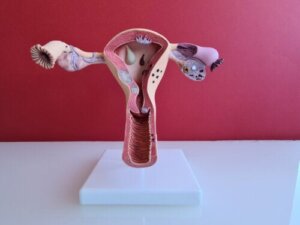Cervical Mucus: 9 Facts Every Woman Should Know

The cervical mucus provides valuable information about a woman’s fertility. It’s a little different in each woman and, therefore, each woman should follow her discharge for a few months in order to identify the changes that signify fertility.
Throughout the menstrual cycle, there are changes in the appearance of this type of mucus. Aspects such as texture, density, and color vary. Let’s take a closer look.
1. What is cervical mucus?
Cervical mucus is a layer of epithelium that lines the area around the cervix. It releases a fluid that flows into the vagina.
This fluid serves to lubricate the area and protects against infection. Its production increases just before and after ovulation, although it’s always being secreted.
It presents different changes throughout the menstrual cycle in aspects such as texture, appearance, and quantity. It’s usually seen in underwear as a clear, white, or slightly yellowish discharge. It’s odorless under normal conditions.
We think you may be interested in reading this, too: 23 Types and Shapes of Vagina: All of Them Are Normal
2. Fertile mucus
A woman’s fertile period occurs in the six days around ovulation. When this occurs, estrogen levels increase, which leads to the cervical mucus producing a thicker, whitish, thick, sticky discharge that’s very similar to egg white.
This is because, during these days, it’s necessary to increase the lubrication of the vagina. In other words, the body prepares for fertilization and generates the conditions that favor it.
Most types of mucus facilitate the movement of sperm.

3. The mucus timeline
The cervical mucus timeline is not the same for all women. Each woman must identify her own.
However, it usually follows this pattern:
- Early cycle: From day 1 to day 5 of the menstrual cycle. This is the stage when menstruation occurs.
- Post-period: From day 5 to day 10. The mucus discharge is very scanty and rather sticky. It indicates low fertility.
- Preovulation: Days 10 to 14. The discharge is more abundant. It looks sticky and cloudy. Towards the end, it becomes viscous and more and more egg white-like.
- Ovulation: This usually occurs around day 14 of the cycle. The discharge from the mucus is very wet and viscous, to the point where it stretches between the fingers. This is the time of greatest fertility.
- Post-ovulation: This occurs from day 14 to 22. The mucus flow begins to dry. At first, it appears somewhat cloudy and then takes on a thick texture.
- Pre-period: Days 22 to day 28. The amount of discharge is greatly reduced, and as the days go by, it becomes much thicker and sticky, similar to glue. Fertility is almost nil.
4. Fertility and the cervical mucus
The cervical mucus provides important data to check fertility. How? It’s best to do the following:
- After using the toilet, wipe the area with toilet paper to remove any urine.
- Wash your hands.
- Gently insert your finger up to one-half inch into the vagina.
- Remove the finger and observe the texture and color of the liquid that remains soaked in it.
- If the fluid is elastic, watery, thin, and clear, it’s most likely a fertile time.
Like this article? You may also like to read: How to Cure Vaginal Candidiasis with Natural Remedies
5. Factors affecting the mucus in the cervix
So far, we’ve described the characteristics of cervical mucus under normal conditions. However, there are many factors that can lead to changes in the quantity and quality of cervical mucus:
- Oral contraceptives reduce the amount of cervical mucus.
- Drugs: Certain antibiotics, antiseptic douches, or suppositories can change cervical mucus.
- Sexually transmitted diseases (STDs) alter the quality of cervical mucus.
- Endocrine disorders cause mucus production to be continuous rather than cyclical.
- Obesity: Secretion is more constant and abundant. Infections of the area are favored.
- Vaginal lubricants alter the composition of the mucosa.
6. Sperm and cervical mucus
The cervical mucus facilitates the transit of spermatozoa. It operates as a kind of fluid-filled gel with an elastic structure.
When ovulation occurs, the water content of this mucus increases. This is very suitable for the sperm to move towards the uterus. At other times in the cycle, the water content is reduced, and this prevents the passage of microbes.
7. The postcoital test
Sometimes, the female body generates antibodies that reject sperm. This causes the sperm to clump together or become immobilized. Consequently, fertility is affected. Nowadays, it’s possible to detect this condition by means of a postcoital test.
This test is performed 2 to 6 hours after sexual intercourse. What the gynecologist does is take a sample of the cervical mucus and then evaluate the mobility of the sperm under the microscope.
8. The importance of drinking water
One of the most interesting facts about cervical mucus is that it becomes of better quality the more water a woman drinks. It helps the flow during ovulation to become more elastic and suitable for sperm transit.
Cervical mucus is 90% water. The changes it undergoes throughout the menstrual cycle depending on estrogen levels. However, drinking too little water causes this discharge to become thicker.

9. You can improve the quantity and quality of cervical mucus
Just as there are factors that affect the cervical mucus negatively, there are also others that give it more quality. These include the following:
- Drink at least eight glasses of water a day.
- Increase your consumption of fruits and vegetables.
- If you’re having problems, you can take certain medications containing guaifenesin, which must be prescribed by a physician.
There is no single trick for fertility
Keeping proper track of the mucus that comes from the cervix helps determine when a woman is most fertile. This should be done for three months to get a clear picture. The data is crucial when trying to conceive.
However, this is not the only definitive data. In some cases, there may be infertility caused by other causes. If a woman wants to get pregnant and is unable to do so, it’s always best to consult a doctor.
All cited sources were thoroughly reviewed by our team to ensure their quality, reliability, currency, and validity. The bibliography of this article was considered reliable and of academic or scientific accuracy.
- Ruiz, Edgar Rivera, Diego Larrea Betancourt, and Ángel Freire Valencia. “Anticoncepción, microbiota vaginal e infecciones de transmisión sexual.” Anticoncepción Hormonal 465 (2021).
- Frost, M., Jarboe, E. A., Orlicky, D., Gianani, R., Thompson, L. C., Enomoto, T., & Shroyer, K. R. (2002). Immunohistochemical localization of survivin in benign cervical mucosa, cervical dysplasia, and invasive squamous cell carcinoma. American journal of clinical pathology, 117(5), 738-744.
- Ovalle, Alfredo, et al. “Obesidad, factor de riesgo de infección bacteriana ascendente durante el embarazo.” Revista médica de Chile 144.4 (2016): 476-482.
This text is provided for informational purposes only and does not replace consultation with a professional. If in doubt, consult your specialist.








